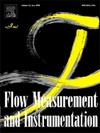基于CFD分析的气体流动标定RoR法温度校正研究
IF 2.3
3区 工程技术
Q2 ENGINEERING, MECHANICAL
引用次数: 0
摘要
上升速率(RoR)法通过测量在测量时间内恒容腔内气体压力和温度的动态变化来确定流量。基于RoR方法的MFV器件通常用于校准热质量流量控制器(mfc),其广泛应用于半导体制造或环境监测中。有效RoR测量数据的起点最好是在温度平衡建立之后。热平衡时间随进口流量的变化而变化。此外,由于流动功现象,腔内气体总温度高于热平衡时腔外壁测得的温度。因此,RoR方法的温度校正和热平衡时间显著影响MFV的精度水平。特别是,气体与腔室之间的热平衡时间和对流换热系数难以直接获得。重点研究了MFV温度校正方法中的关键参数:对流换热系数和热平衡时间。基于氮气介质瞬态计算流体力学(CFD)模拟,我们选择研究RoR测量过程中压力、温度和对流换热系数随时间的变化,定义了适用于实际测量的热平衡时间,并分析了各参数对温度校正的影响,特别是对流换热系数和热平衡时间对温度的影响机理。最后,在模拟的基础上提出了3 ~ 3000 sccm N2当量范围内MFV的温度校正方法,校正精度低于1%。本文章由计算机程序翻译,如有差异,请以英文原文为准。
Investigation on the temperature correction in RoR method for the calibration of gas flow based on CFD analysis
The rate-of-rise (RoR) method determines flow by measuring the dynamic changes in gas pressure and temperature within a constant volume chamber during the measurement time. MFV devices based on the RoR method are commonly used to calibrate thermal mass flow controllers (MFCs), which are widely-used in semiconductor manufacturing or environmental monitoring. Starting point of valid data for RoR measurement is preferably after temperature equilibrium has been established. The thermal equilibrium time varies with inlet flow. Additionally, due to the flow work phenomena, the total gas temperature inside the chamber is higher than the temperature measured at the outer wall of the chamber at thermal equilibrium. Therefore, the temperature correction in RoR method and thermal equilibrium time significantly affect the accuracy level of the MFV. Particularly, thermal equilibrium time and convective heat transfer coefficient between the gas and the chamber is difficult to obtain directly.
We focus on the key parameters in the MFV temperature correction method: convective heat transfer coefficient and thermal equilibrium time. Based on transient computational fluid dynamics (CFD) simulations in a nitrogen medium, we have chosen to study pressure, temperature, and convective heat transfer coefficients over time during the RoR measurement process, defined the thermal equilibrium time applicable to actual measurements, and analyzed the influence of each parameter in the temperature correction, especially the mechanisms of the convective heat transfer coefficient and thermal equilibrium time on temperature. Finally, the temperature correction method for MFV which range is 3–3000 sccm N2 equivalent is proposed based on simulation, which accuracy is lower than 1 %.
求助全文
通过发布文献求助,成功后即可免费获取论文全文。
去求助
来源期刊

Flow Measurement and Instrumentation
工程技术-工程:机械
CiteScore
4.30
自引率
13.60%
发文量
123
审稿时长
6 months
期刊介绍:
Flow Measurement and Instrumentation is dedicated to disseminating the latest research results on all aspects of flow measurement, in both closed conduits and open channels. The design of flow measurement systems involves a wide variety of multidisciplinary activities including modelling the flow sensor, the fluid flow and the sensor/fluid interactions through the use of computation techniques; the development of advanced transducer systems and their associated signal processing and the laboratory and field assessment of the overall system under ideal and disturbed conditions.
FMI is the essential forum for critical information exchange, and contributions are particularly encouraged in the following areas of interest:
Modelling: the application of mathematical and computational modelling to the interaction of fluid dynamics with flowmeters, including flowmeter behaviour, improved flowmeter design and installation problems. Application of CAD/CAE techniques to flowmeter modelling are eligible.
Design and development: the detailed design of the flowmeter head and/or signal processing aspects of novel flowmeters. Emphasis is given to papers identifying new sensor configurations, multisensor flow measurement systems, non-intrusive flow metering techniques and the application of microelectronic techniques in smart or intelligent systems.
Calibration techniques: including descriptions of new or existing calibration facilities and techniques, calibration data from different flowmeter types, and calibration intercomparison data from different laboratories.
Installation effect data: dealing with the effects of non-ideal flow conditions on flowmeters. Papers combining a theoretical understanding of flowmeter behaviour with experimental work are particularly welcome.
 求助内容:
求助内容: 应助结果提醒方式:
应助结果提醒方式:


